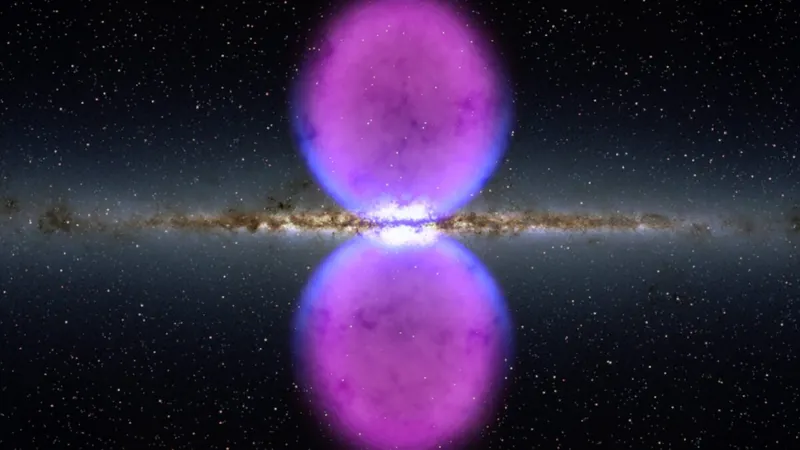
‘Ice Cubes in a Volcano’: Scientists Stunned by Frigid Clouds in the Heart of the Milky Way
2025-07-19
Author: William
Mysterious Fermi Bubbles Spark Intrigue
The heart of our Milky Way galaxy is home to breathtakingly massive structures known as the Fermi bubbles—gigantic, balloon-like formations of high-energy radiation soaring thousands of light-years above and below the galactic plane. These colossal lobes are believed to be the aftermath of a dramatic outburst that rocked our galaxy not long ago, and a recent discovery has taken this mystery to new heights.
Cooling Off in Extreme Heat: A Surprising Find
Researchers using the National Science Foundation's Green Bank Telescope in West Virginia stumbled upon a mind-boggling phenomenon: pockets of cold hydrogen clouds existing within the blazing environment of the Fermi bubbles. These clouds, astonishingly, are just a few million years old—practically newborns in cosmic terms. This revelation challenges scientists to unravel how such cooler gas can thrive in an atmosphere that’s superheated.
Fermi Bubbles: A Blast from the Past
Discovered in 2010 by NASA's Fermi Gamma-ray Space Telescope, these Fermi bubbles form an hourglass shape with each lobe towering approximately 25,000 light-years high. Composed of gamma rays and high-energy cosmic rays, they represent a cataclysmic event likened to a massive volcanic eruption, according to Rongmon Bordoloi, an associate professor at North Carolina State University and co-author of the groundbreaking research.
An Unexpected Mix of Hot and Cold
While diving into the composition of these Fermi bubbles, the research team found most of the gas averages around 1 million degrees Kelvin. However, nestled within this inferno were clouds of neutral hydrogen gas, located around 12,000 light-years from the galaxy's center, weighing in at several thousand solar masses.
Strikingly, these hydrogen clouds are a mere 10,000 degrees Kelvin—cooler than their fiery surroundings by a staggering factor of 100. Andrew Fox, an astronomer at the Space Telescope Science Institute, likens the discovery to finding "ice cubes in a volcano," an analogy that captures the essence of this intriguing phenomenon.
The Youth of the Fermi Bubbles
Given the extreme conditions within the Fermi bubbles, the existence of these hydrogen clouds throws a wrench into previously held beliefs; they shouldn’t have lasted more than a few million years in such a heated environment. Bordoloi emphasizes, "If the Fermi bubbles were 10 million years old or older, the clouds wouldn’t be detectable at all." This suggests that the Fermi bubbles are much younger than scientists anticipated.
A Dance of Gas and Wind in the Galaxy
Researchers propose that these cold clouds were swept up from the galactic center and carried along by the hot winds that gave rise to the Fermi bubbles. Jay Lockman, an astronomer at the Green Bank Observatory, provides a relatable comparison: "Just as we can't perceive wind without seeing the clouds it pushes, we can't see the hot galactic winds, but we detect the radio emissions from the cold clouds it transports."
This unraveling tale of cosmic interactions not only enhances our understanding of the Milky Way's evolution but also beckons further investigation into the enigmatic forces at play in our universe.









 Brasil (PT)
Brasil (PT)
 Canada (EN)
Canada (EN)
 Chile (ES)
Chile (ES)
 Česko (CS)
Česko (CS)
 대한민국 (KO)
대한민국 (KO)
 España (ES)
España (ES)
 France (FR)
France (FR)
 Hong Kong (EN)
Hong Kong (EN)
 Italia (IT)
Italia (IT)
 日本 (JA)
日本 (JA)
 Magyarország (HU)
Magyarország (HU)
 Norge (NO)
Norge (NO)
 Polska (PL)
Polska (PL)
 Schweiz (DE)
Schweiz (DE)
 Singapore (EN)
Singapore (EN)
 Sverige (SV)
Sverige (SV)
 Suomi (FI)
Suomi (FI)
 Türkiye (TR)
Türkiye (TR)
 الإمارات العربية المتحدة (AR)
الإمارات العربية المتحدة (AR)